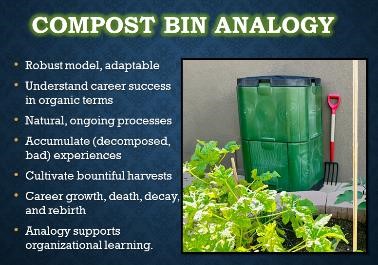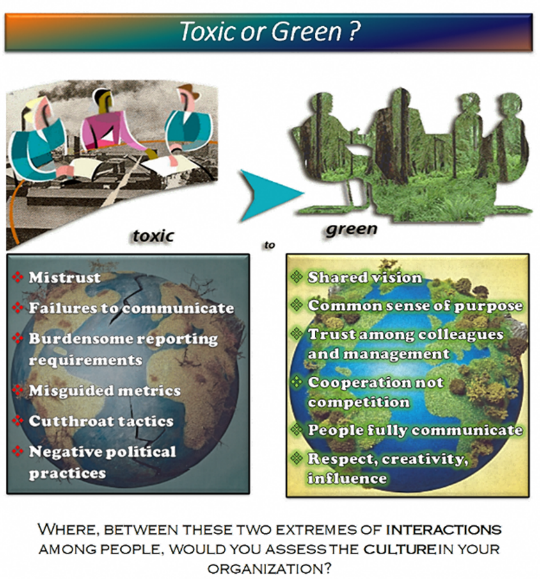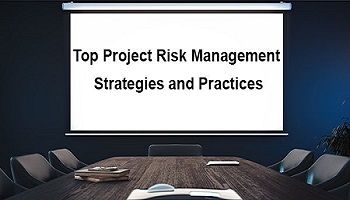A widespread desire to improve organizational performance may be sated by focusing on a key set of necessary and high priority actions—imperatives. An essential focus on creating excellence in people, processes, and the working environment reaps tremendous benefits and enables executives and their organizations to achieve desired objectives. Leadership skills and environmental factors provide significant impetus towards sustainable success.
An ecosystem is a community of interacting organisms and their physical environment. A “green ecosystem” creates an environment for consistent, predictable, and sustainable success. It eliminates “toxic” substances and provides projects with a physical and mental context that allows them to prosper. This allows management to focus on overall organizational success, not just on individual project performance. People then feel like they are constantly contributing to organizational and personal knowledge and creating growth.
Keywords: Leadership, organizational maturity, green ecosystem, organizational learning, sustainable success, biomimicry, project management, sponsorship.
To the questions:
- What types of leadership skills and employee competency and training are necessary to affect successful organizational transformations?
- How does biomimicry influence the design of an organizational architecture?
Without a “green” foundation, organizations experience failures, budget and schedule overruns, lack of trust, and dissatisfied stakeholders. People leave, often because leaders do not meet their needs, and witness the “great resignation.” New generations want different work conditions. These “toxic” work environments are usually permeated by political practices that create uneasiness and frustration among all except those who wield these negative practices with power. Trust in institutions and governments is weak.
Progressively improving practices, also called organizational maturity, requires that project leaders and management reduce organizational “toxins” and create “green” organizations. “Green” in this context extends the physical, tangible thinking about project work into the nonphysical, intangible personal working relationships that affect our working environments. In this sense, in an “ecosystem” that allows good project management and complete project manager mindsets to grow, “green” is good.
An ideal situation is proactive leaders who are committed, accountable, and serious about projects they select and sponsor; they are knowledgeable, trained, and able not only to talk the talk but also to walk the walk. Such people are trustworthy in all respects. Trust is seen as earned by being competent and acting for the common good. Their values are transparent and aligned with the organization and its strategy. Such sponsors protect the team from disruptive outside influences, do not operate through fear, and back the team up when times are tough.
A key need and imperative is to support organizational learning, even at the risk of tolerating some failures. Executives at all levels set the tone for how failure and learning are perceived. Take the time to share thinking, standards, and expectations. Provide appropriate rewards, not only for successes but also for failures that led to heightened understanding about risks, things to avoid, and innovative approaches. Conduct retrospectives on all projects: what went well, lessons learned, what do differently. Tap biomimicry as a tool to learn from nature and create organic solutions to challenges. The goal is to establish higher priority for continuous learning that gets recycled into new best practices.
Compost Bin Analogy
A compost bin is an apt analogy for a green ecosystem. The compost pile offers a robust model, a model adapted to changing times and to the new millennium. It is a model of growth, of sharing, of happiness. It is a way of understanding career success in organic terms—where the accumulation of life’s (decomposed) experiences provides a broad and fertile base on which to cultivate and accumulate new and ever more valuable experiences. The pile grows ever fuller, without losing stability. It is about career growth, death, decay and rebirth. Whatever comes along in life, just put it on the pile and let it ripen.

Metaphysically speaking, people are the sum total of what people learn, what people experience, what people create. People increase in knowledge and in wisdom, taking what is given to them by the sun and giving it back to the world that is illumined and warmed, also by the sun. In the end, people can do little more than pass on the wisdom that they have accumulated. Then people also become the soil, quite literally uniting the humus of themselves to a collective wisdom. With a model such as this, progress is judged to be in what people will have become, and not in how high people will have climbed. There is purpose and value in all of life’s experiences.
People need to interpret and evaluate careers and lives according to a model, and they need to be free to choose which model to use. This is a biomimicry model by which people might use the light of the sun to photosynthesize their happiness. Create an organic approach to the implementation of all endeavors, especially those driven by projects. Learn how nature operates and seek ways to incorporate organic approaches in all endeavors. An organic organization is one where people feel they operate naturally, comfortably, and happily.
Advertisement
[widget id=”custom_html-68″]
Most professionals need to take responsibility, self-manage, and continuously develop their careers. The compost pile analogy fits with reference to molecular structure as an organic depiction of a more complete project manager. Through natural, ongoing processes, scraps turn into beautiful humus… but not without some stinky in-between steps. By adding waste products such as manure (which can be thought of as a metaphor for learning from bad experiences) to the compost, the process of creating rich soil is accelerated. The output, when the soil is added back into nature’s garden, is a bountiful harvest. Similarly, people become better persons, managers, and leaders by continually expanding and growing their skills and using lessons learned.
To address the most crucial executive actions, look at the ingredients needed for success—form an organizational architecture. Outline the need for actions and focus. This resembles an ecosystem—a community of interacting organisms and their physical environment. Just as in nature, trees, flowers, and animals need a suitable ecosystem in order to develop, grow and bloom. So do projects. Dispersion of power, transparency, and mutual accountability enhance thriving organizations. High correlation of these factors leads to environmental sanity.
The natural sciences state that all objects start with their particular genetic combination which allows them to grow and prosper. It is the environment in form of light, water, air, and sustenance that hinders or supports genetically given development. So, plants that are genetically equal when they are seeded will develop differently when exposed to different environmental circumstances. Projects are not different. Projects grow and prosper when their environment allows for it. Be cognizant that the working environment takes care of a particular set of genes (such as project type, size, geography, and number of projects as well as stakeholders’ power, interests, and relevant skills) to allow them to develop into successful endeavors. Executive management puts this “ecosystem” in place. Establish the equivalent of the right soil, water, fertilizer, and light in place so that the organization can prosper and bloom through more successful projects.
Replace thought traps—e.g., how we do things here, won’t work here—with leading practices, culled from experience. Learn how to integrate key people, team, business, technical, and organizational skills, tapping multiple disciplines. Apply reframing tools that are often as simple to apply as thinking differently. Feed imaginations by beauty, not by fear. Open doors and walk into new spaces. Align efforts with laws of life. Shift from controls to co-creating with nature. Encourage curiosity, ask and share “why”, and look for causal patterns. Be aware of vested interests and biases. Know that life is continuous change; the same is also true for organizational dynamics.
Just as our physical planet is facing existential threats, so do organizations. Much is written that socially responsible firms perform better financially than less responsible competitors. Prioritizing sustainability leads to better results. Know that concentration of power, whether politically or social, undercuts democracy. Help people gain control over their lives and work with autonomy. Leaders can set new precedents and change the norms and rules of societies so that negative human tendencies are kept in check. Elicit powerful, positive qualities that are most needed. Be a positive role model. Communicate a sense of possibility, more so than probability. Dissolve the presumption of lack; actively nurture positive proclivities. Focus on business outcomes, more so than project outputs.

It is possible to escape the constraints of evolution…by learning about our environments, imagining differences, and turning those imaginations into reality. Much as in nature where configurations of atoms are essentially infinite and lead to marvelous assemblies and products, people skills operating through individual and expanding personalities can contribute in infinite ways. While our planet may experience limits to growth, innovation does not have the same limits. Creativity needs always to be welcomed.
The imperative facing leaders in all organizations is not only to embark on a quest to manage processes such as business analysis, project, program, and portfolio management, but also to create “green ecosystems.” Continually improve environments that encourage project-based work. A meaningful goal is to eliminate people interaction pollutants and “toxic” actions that demotivate project managers and their teams. This means searching with unrelenting curiosity for leading practices. It also means, when these practices are revealed, that leaders are prepared to take action. Integrating executive leadership with new thinking, guided by an eco-guide, make the difference that leads to competitive advantages for organizations These are places where people do their best work. Wise leaders adopt, adapt, and apply these leadership imperatives.
Other Resources:
Englund, R. L., and Bucero, A. Project Sponsorship: Achieving Management Commitment for Project Success. (2nd ed.) Newtown Square, PA.: Project Management Institute, 2015.
Englund, R. L., and Bucero, A. The Complete Project Manager: Integrating People, Organizational, and Technical Skills. (2nd ed.) Oakland, Calif.: Berrett-Koehler Publishers, 2019.
Englund, R. L., and Bucero, A. The Complete Project Manager’s Toolkit, updated. https://englundpmc.com/product/toolkit/, 2019.
Englund, R. L., and Graham, R. J. Creating an Environment for Successful Projects. (3rd ed) Oakland, Calif.: Berrett-Koehler Publishers, 2019.
Lappe, F.M. EcoMind: Changing the Way We Think, to Create The World We Want. New York: Nation Books, 2011.






